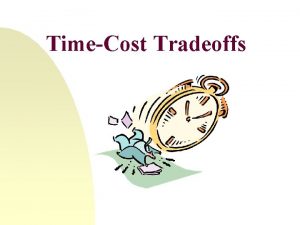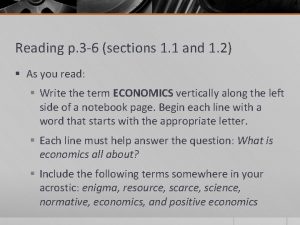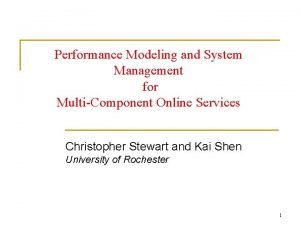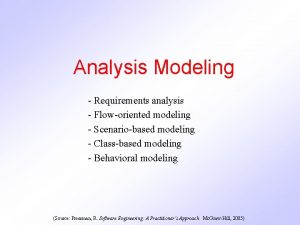Modeling and Analysis of Performance Interaction and Tradeoffs


![Example 1. [Cloud. Transactions, SIGMOD 2010] Kossmann, Kraska, and Loesing. An evaluation of alternative Example 1. [Cloud. Transactions, SIGMOD 2010] Kossmann, Kraska, and Loesing. An evaluation of alternative](https://slidetodoc.com/presentation_image_h2/34669b271febd4cbcca17cebfbfe093f/image-3.jpg)
![Example 2. [Database. Serializability, SIGMOD 2006] Bernstein, Fekete, Guo, Ramakrishnan, and Tamma. Relaxed-currency serializability Example 2. [Database. Serializability, SIGMOD 2006] Bernstein, Fekete, Guo, Ramakrishnan, and Tamma. Relaxed-currency serializability](https://slidetodoc.com/presentation_image_h2/34669b271febd4cbcca17cebfbfe093f/image-4.jpg)
![Example 3. [Map. Reduce, IJPP 2013] Vianna, Comarela, Pontes, Almeida, Wilkinson, Kuno, and Dayal. Example 3. [Map. Reduce, IJPP 2013] Vianna, Comarela, Pontes, Almeida, Wilkinson, Kuno, and Dayal.](https://slidetodoc.com/presentation_image_h2/34669b271febd4cbcca17cebfbfe093f/image-5.jpg)
![Example 4. [Datacenter. AMP, Hot. Power 2010] Gupta and Nathuji. Analyzing performance asymmetric multicore Example 4. [Datacenter. AMP, Hot. Power 2010] Gupta and Nathuji. Analyzing performance asymmetric multicore](https://slidetodoc.com/presentation_image_h2/34669b271febd4cbcca17cebfbfe093f/image-6.jpg)
![Example 5. [Elastic. Scaling, ICAC 2012] Didona, Romano, Peluso, and Quaglia. Transactional auto scaler: Example 5. [Elastic. Scaling, ICAC 2012] Didona, Romano, Peluso, and Quaglia. Transactional auto scaler:](https://slidetodoc.com/presentation_image_h2/34669b271febd4cbcca17cebfbfe093f/image-7.jpg)

- Slides: 8

Modeling and Analysis of Performance Interaction and Tradeoffs in the Cloud Y. C. Tay National University of Singapore

job execution in the cloud: modeling techniques for analyzing • tradeoffs throughput vs correctness latency vs energy etc. • interactions resource contention vs data contention resource contention vs precedence constraints demand vs supply etc. 5 examples
![Example 1 Cloud Transactions SIGMOD 2010 Kossmann Kraska and Loesing An evaluation of alternative Example 1. [Cloud. Transactions, SIGMOD 2010] Kossmann, Kraska, and Loesing. An evaluation of alternative](https://slidetodoc.com/presentation_image_h2/34669b271febd4cbcca17cebfbfe093f/image-3.jpg)
Example 1. [Cloud. Transactions, SIGMOD 2010] Kossmann, Kraska, and Loesing. An evaluation of alternative architectures for transaction processing in the cloud. issue: scalability limit of cloud architecture distributed control classic partition distributed control bottleneck analysis for blackbox cloud architecture suffice for analyzing/comparing scalability limits
![Example 2 Database Serializability SIGMOD 2006 Bernstein Fekete Guo Ramakrishnan and Tamma Relaxedcurrency serializability Example 2. [Database. Serializability, SIGMOD 2006] Bernstein, Fekete, Guo, Ramakrishnan, and Tamma. Relaxed-currency serializability](https://slidetodoc.com/presentation_image_h2/34669b271febd4cbcca17cebfbfe093f/image-4.jpg)
Example 2. [Database. Serializability, SIGMOD 2006] Bernstein, Fekete, Guo, Ramakrishnan, and Tamma. Relaxed-currency serializability for middle-tier caching and replication. issues: interaction between performance and correctness interaction between user and system two forces: resource contention (performance) over cycles, disks, bandwidth data contention (correctness) transactions block, abort interact: more data contention more blocking more stale data less resource contention more caches more copying system's supply curves users control demand curve performance more aborts more wasted resources less data contention more network contention intersection determines equilibrium decouples user and system behavior correctness
![Example 3 Map Reduce IJPP 2013 Vianna Comarela Pontes Almeida Wilkinson Kuno and Dayal Example 3. [Map. Reduce, IJPP 2013] Vianna, Comarela, Pontes, Almeida, Wilkinson, Kuno, and Dayal.](https://slidetodoc.com/presentation_image_h2/34669b271febd4cbcca17cebfbfe093f/image-5.jpg)
Example 3. [Map. Reduce, IJPP 2013] Vianna, Comarela, Pontes, Almeida, Wilkinson, Kuno, and Dayal. Analytical performance models for Map. Reduce workloads. issue: interaction between resource contention and precedence constraint bad good more wasted time less resource contention queueing model set up to use MVA recursion algorithm from queueing theory model decomposition: precedence model violates MVA assumptions don't worry about modeling assumptions wait for experimental validation
![Example 4 Datacenter AMP Hot Power 2010 Gupta and Nathuji Analyzing performance asymmetric multicore Example 4. [Datacenter. AMP, Hot. Power 2010] Gupta and Nathuji. Analyzing performance asymmetric multicore](https://slidetodoc.com/presentation_image_h2/34669b271febd4cbcca17cebfbfe093f/image-6.jpg)
Example 4. [Datacenter. AMP, Hot. Power 2010] Gupta and Nathuji. Analyzing performance asymmetric multicore processors for latency sensitive datacenter applications. issue: tradeoff between latency and power use smaller core to save power: use bigger core to speed up: latency model: M/M/1 queue power model: uses Amdahl's Law simple models suffice for analyzing rich behvior
![Example 5 Elastic Scaling ICAC 2012 Didona Romano Peluso and Quaglia Transactional auto scaler Example 5. [Elastic. Scaling, ICAC 2012] Didona, Romano, Peluso, and Quaglia. Transactional auto scaler:](https://slidetodoc.com/presentation_image_h2/34669b271febd4cbcca17cebfbfe093f/image-7.jpg)
Example 5. [Elastic. Scaling, ICAC 2012] Didona, Romano, Peluso, and Quaglia. Transactional auto scaler: elastic scaling of in-memory transactional data grids. issue: tenant needs a tool to scale their resources in the cloud data contention: whitebox model of transactions resource contention: blackbox model of cloud machine learning model decomposition to decouple data contention and resource contention

summary: • use model decomposition to analyze interaction between forces resource contention vs data contention [Elastic. Scaling] resource contention vs precedence constraint [Map. Reduce] demand vs supply [Database. Serializability] • system too complicated? bottleneck analysis machine learning [Cloud. Transactions] [Elastic. Scaling] • don't worry about assumptions use the formulas and algorithms anyway go with experimental validation [Map. Reduce] [Datacenter. AMP] more details/examples in:















